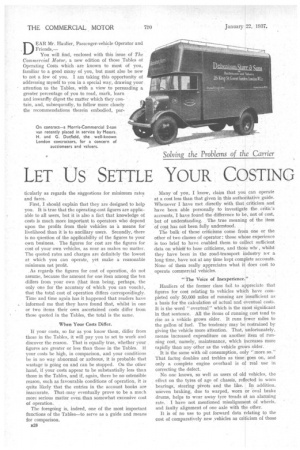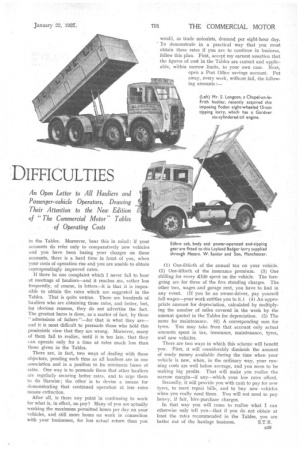LET US SETTLE YOUR COSTING DIFFICULTIES
Page 38

Page 39

If you've noticed an error in this article please click here to report it so we can fix it.
E.DAR Mr. Haulier, Passenger-vehicle Operator and Friends,— You will find, enclosed with this issue of The Commercial Motor, a new edition of those Tables of Operating Costs which • are known to most of you, familiar to a good many of you, but must also be new to not a few of you. I am taking this opportunity of addressing myself to you in a special way, drawing your attention to the Tables, with a view to persuading a greater percentage of you to read, mark, learn and inwardly digest the matter which they contain, and, subsequently, to follow more closely . the recommendations therein embodied, par
ticulariy as regards the suggestions for minimum rates and fares. .
First, I should explain that they are designed to help you. It is true that the operating-cost figures are applicable to all users, but it is also a fact that knowledge of costs is much more important to operators who depend upon the profits from their vehicles as a means for livelihood than it is to ancillary users. Secondly, there is no question of the applicability of the figures to your own business. The figures for cost are the figures for cost of your own vehicles, as near as makes no matter. The quoted rates and charges are definitely the lowest at which you can operate, yet make a reasonable minimum net profit.
As regards the figures for cost of operation,. do not assume, because the amount for one item among the ten differs from your own (that item being, perhaps, the only one for the accuracy of which you can vouch), that the total cost of operation differs corresporklingly. Time and time again has it happened that readers have informed me that they have found that, whilst in one or two items their own ascertained costs differ from those quoted in the Tables, the total is the same.
When Your Costs Differ.
If your costs, so far as you know them, differ from those in the Tables, it will pay you to set to work and discover the reason. That is equally true, whether your figures are greater or less than those in the Tables. If your costs be high, in comparison, and your conditions be in no way abnormal or arduous, it is probable that wastage is going on and can be stopped. On the other hand, if your costs appear to be substantially less than those in the Tables, and if, again, there be no ostensible reason, such as favourable conditions of operation, it is quite likely that the entries in the account books are inaccurate. That may eventually prove to be a much more serious matter even than somewhat excessive cost of operation.
The foregoing is, indeed, one of the most important functions of the Tables—to serve as a guide and means for comparison.
B2.8 Many of you, I know, claim that yoli can operate at a cost less than that given in this authotitative guide. Whenever I have met directly with that criticism and have been able personally to investigate the critic's accounts, I have found the difference to be, not of cost, but of understanding. The true meaning of the item of cot has not been fully understood.
The bulk of these criticisms come fron one or the other of two classes of operator : those whose experience is too brief to have enabled them to collect sufficient data on whioll to base criticisms, and thole wh( , whilst they have been in the road-transport industry tor a long time, have not at any time kept complete accounts.
None of them really appreciates what it does cost to operate commercial vehicles. 1 "The Voice of Inexperience.,
Hauliers of the former class fail to appreciate that figures for cost relating to vehicles whieh have completed only 50,000 miles of running are linsufficient as a basis for the calculation of actual and eventual costs. It is the word "eventual" which is the Most significant in that sentence. All the items of running cost tend to rise as a vehicle grows older. It runs fewer miles to the gallon of fuel. The tendency may be restrained by giving the vehicle more attention. That, !unfortunately, means increased expenditure on another item of running cost, namely, maintenance, which increases more rapidly than any other as the vehicle grows older.
. It is the same with oil consumption, only "more so." That factor doubles and trebles as time goes on, and only a complete engine overhaul is o', real use in correcting the defect.
No one knows, so well as users of old vehicles, the effect on the tyres of age of chassis, refilected in worn bearings, steering pivots and the like. 1 In addition, uneven braking, due to warped, worn Or oval brake drums, helps to wear away tyre treads aft an alarming rate. I have not mentioned misalignment of wheels, and faulty alignment of one axle with t3 e other.
It is of no use to put forward data elating to the cost of comparatively new vehicles as criticism of those in the Tables. Moreover, bear this in mind : if your accounts do refer only to comparatively new vehicles and you have been basing your charges on these accounts, there is a hard time in front of you, when your costs of operation rise and you are unable to obtain correspondingly improved rates.
If there be one complaint which I never fail to hear at meetings of hauliers—and it reaches me, rather less frequently, of course, in letters—it is that it is impossible to obtain the rates which are suggested in the Tables. That is quite untrue. There are hundreds of hauliers who are obtaining those rates, and better, but, for obvious reasons, they do not advertise the fact. The greatest harm is done, as a matter of fact, by these "admissions of failure "—for that is what they are— and it is most difficult to persuade those who hold this pessimistic view that they are wrong. Moreover, many of them fail to realize, until it is too late, that they can operate only for a time at rates much less than those given in the Tables.
There are, in fact, two ways of dealing with these objectors, pending such time as all hauliers are in one association and in a position to fix minimum bases of rates. One way is to persuade them that other hauliers are regularly securing better rates, and to urge them to do likewise ; the other is to devise a means for demonstrating that continued operation at less rates means extinction.
After all, is there any point in continuing to work for what is, in effect, no pay? Many of you are actually working the maximum permitted hours per day on your vehicles, and still more hours on work in connection with your businesses, for less actual return than you
would, as trade unionists, demand per eight-hour day. To demonstrate in a practical way that you must obtain these rates if you are to continue in business, follow this plan. First, accept my earnest assertion that the figures of cost in the Tables are correct and applicable, within narrow limits, to your own case. Next, open a Post Office savings account. Put away, every week, without fail, the following amounts :—
(I) One-fiftieth of the annual tax on your vehicle. (2) One-fiftieth of the insurance premium. (3) One shilling for every £100 spent on the vehicle. The foregoing are for three of the five standing charges. The other two, wages and garage rent, you have to find in any event. (If you be an owner-driver, pay yourself full wages—your work entitles you to it.) (4) An appropriate amount for depreciation, calculated by multiplying the number of miles covered in the week by the amount quoted in the Tables for depreciation. (5) The same for maintenance. (6) A corresponding sum for tyres. You may take from that account only actual amounts spent in tax, insurance, maintenance, tyres, and new vehicles.
There are two ways in which this scheme will benefit you. First, it will considerably diminish the amount of ready money available during the time when your vehicle is new, when, in the ordinary way, your running costs are well below average, and you seem to be making big profits. That will make you realize the narrow margin—if any—which your low rates afford.
Secondly, it will provide you with cash to pay for new tyres, to meet repair bills, and to buy new vehicles when you really need them. You will not need to pay heavy, if fair, hire-purchase charges.
In that way you will come to realize what I can otherwise only tell you—that if you do not obtain at least the rates recommended in the Tables, you are better out of the haulage business. S.T.R.
















































































































